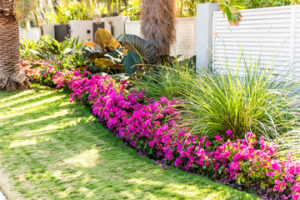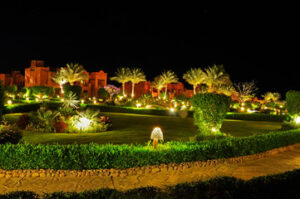Landscaping is the arrangement of outdoor features like lawns, gardens, patios, and outdoor living spaces. It can also involve construction of structures like driveways, fences, and retaining walls.

Using xeriscaping techniques in your landscape conserves energy and reduces pollution by reducing water use. This is done by utilizing native plants that thrive in your climate and soil type. Contact Landscapers Fayetteville AR for professional help.
Landscaping involves the design and modification of outdoor spaces to improve usability, aesthetics, and environmental sustainability. This can include adding or removing plants, altering terrain shape and slope, or using structures like patios, walkways, and retaining walls. It also includes the arrangement of these elements in a thoughtful, functional manner. Often, the goal is to create a landscape that blends seamlessly with the surrounding natural environment.
The process of designing a landscape begins with assessing the site and understanding your needs. It then involves creating functional diagrams and a conceptual plan to guide the installation of your new landscape. It is important to keep in mind that a successful landscape should reflect the natural beauty of your surroundings and incorporate horticultural best practices.
A well-designed landscape should also provide you with a variety of opportunities for enjoyment and interaction with your property. From a relaxing retreat to an outdoor entertainment space, it should be an area that provides you with a sense of purpose and personal satisfaction.
Balance is another key element of a good landscape. This is achieved by balancing hardscaping and softscaping elements, as well as color schemes and textures. The use of scale is also an important factor in creating a balanced landscape. For example, paths designed for an individual experience should be smaller than those that are meant for a group or a family.
When choosing plants, it is important to select species that thrive in your climate and soil conditions. This will help you avoid costly maintenance and watering, as well as reduce the need for fertilizers and chemicals. Adding native plants to your landscape can add to the overall aesthetic of your space and promote biodiversity.
Properly positioned trees can save energy costs by shading the house during summer and blocking cold winter winds, while at the same time increasing property values. Additionally, a thoughtfully designed landscape can enhance the safety of your home by deterring crime and reducing visibility in dark or stormy weather. This can be done through the use of proper lighting and strategic plantings.
Plantings
The plantings (trees, shrubs, groundcovers and flowers) of a landscape are the foundation for the overall design. They provide structure, color and texture to the design, link buildings or tall plants with the lower layer of vegetation, provide a buffer from noise or view pollution and help to control erosion. When designing the plantings of a landscape, it is important to consider the microclimate of the site, such as the amount of sunlight and shade, the direction of sunlight at sunrise and sunset, and the wind patterns in summer and winter. It is also important to select plants that are well-adapted to the local climate.
Plantings are often used in groups, lines or masses to achieve a particular effect. When groups are used, it is important to vary height and leaf texture as well as color to create visual interest. Lines are used to define areas, link structures or trees with the ground layer and can be a good way to emphasize a focal point in a design. In mass plantings, the plants are placed closely together and can create a more natural look.
When starting a landscaping business, it is helpful to set up a separate bank account for your business. This will allow you to keep your personal and business finances separate, which can help with bookkeeping and tax preparation. It is also a good idea to obtain insurance, such as general liability and workers’ compensation, to protect your business against potential risks and liabilities.
Creating a strong online presence can be a great way to promote your landscaping services and reach new clients. Optimize your website for local search and include a contact form to facilitate communication with prospective customers. Additionally, make sure to follow up with any inquiries promptly and provide detailed quotes that outline your pricing, payment terms and cancellation policies.
Landscaping is a highly competitive industry, and it is important to stay on top of your game by maintaining consistent quality, customer service and innovation. Maintaining stringent financial oversight is also key to maximizing profits. Keeping detailed records of income and expenses will help you identify opportunities to cut costs, as well as improve your cash flow management. A qualified accountant or bookkeeper can help you implement an efficient accounting system and offer advice on best business practices.
Maintenance
Landscaping isn’t a one-time event; it’s an ongoing process that requires regular upkeep. A well-maintained landscape can add beauty, value, and functionality to a property. Seasonal landscaping maintenance can include lawn mowing, trimming, edging, fertilization, weed control, pest management, and tree care. It can also include laying mulch, pruning and shaping shrubs and bushes, raking leaves and debris, and cleaning hardscape surfaces.
Adding seasonal elements to your landscape can make it more appealing and add variety. For example, planting flowers that bloom in different seasons can create a colorful display throughout the year. A well-maintained garden also improves a property’s curb appeal and can increase its resale value.
The success of a landscaping business depends on the ability to attract and retain customers. One way to do this is by offering a free estimate or consultation for new clients. This can help you establish trust and gain a competitive edge over other companies. You can also offer a referral program to reward existing customers for their loyalty.
Another key factor in a successful landscaping business is the ability to efficiently manage labor costs. This can be accomplished by using an online tool that allows you to track employee time and projects. It can also help you optimize your budget by reducing waste and increasing productivity.
Insurance is also important for landscaping businesses. It can protect your assets in case of a fire or theft, and it can cover legal fees if you are sued by a client for damages or negligence. Some types of insurance to consider for your landscaping business include equipment and tool insurance, professional liability insurance, and commercial general liability insurance.
A well-designed website can boost your credibility as a landscaping company and generate leads. It can also help you showcase your portfolio, testimonials, and certifications to reinforce your expertise in the field. Additionally, a professional website makes it easier for clients to contact you, thereby increasing your conversion rate. You can also use remarketing campaigns to reach out to potential customers who have visited your site but haven’t yet made a purchase.
Hardscaping
The hardscaping aspect of your landscape involves using non-living materials such as stone, brick, concrete and wood to build functional structures throughout your property. These structures can include patios, walkways, decks, retaining walls, water features and fire pits. Hardscaping complements and supports the soft components of your landscape design, creating a balanced and cohesive outdoor space.
The purpose of your hardscaping is to create a visual focal point for the outdoor space that draws the eye. It also serves to help direct traffic throughout your yard and define areas of your landscape. For example, a walkway of stepping stones through your garden can help people navigate without trampling on plants and soil. Similarly, a patio or firepit provides an area for relaxing or entertaining and is a great way to increase the usable space of your home.
Another function of hardscaping is to protect soft sloping soil and prevent erosion. For instance, retaining walls are excellent for leveling uneven ground and can be used to build steps or paths up and down hills or ravines. In addition, stone and concrete paving helps keep moisture away from dirt, keeping the environment dry and preventing the growth of unwanted weeds or mildew.
Because they are inanimate, hardscape elements require significantly less maintenance than their horticultural counterparts. This is one of the many reasons why hardscape is so attractive to homeowners. It provides the foundation for your landscaping, allowing you to focus on the plantings and flowers that add color and vitality to your space.
Hardscaping can be designed to match your house or reflect the style and feel of your home’s exterior. For instance, you could use flagstones that are the same color as your siding to make the two environments blend seamlessly. Additionally, you can use materials with a high solar reflectance index (SRI) to help reduce the amount of heat that is absorbed by your hardscaping and outdoor space.
Like other parts of your landscape, your hardscaping will need regular care and upkeep. It’s important to address issues such as weeding, watering and pruning, but it’s also a good idea to apply a stain or sealant on a regular basis. This will help prevent cracks and chips as well as maintain a consistent look. It’s also important to ensure that all your hardscapes are anchored properly and settled below the frost line to avoid shifting and movement as the earth expands and contracts throughout the seasons.
